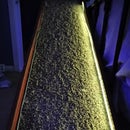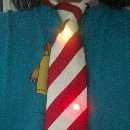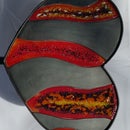Introduction: Candy Delivery Monster
The Candy Delivery Monster is the final module in a bigger Halloween themed Rube Goldberg-like system that members of the Marin Makerspace is making for the Bon Air Center Halloween Bash 2014. Kids come to the shopping center and, besides trick-or-treating at the stores, they donate food (for the Marin Food Bank) or purchase tickets (for the Imagination Foundation) to trigger the Candy Delivery Rube Goldberg-like system. Kids start the system by dropping a canned food item to the starting module. That module does something and at the end signals another module to begin. This repeats from module to module until the final module is reached where the actual candy is delivered to the kid.
The modules are self-contained units of interaction each created by a member. At a technical level, each module needs to have an input signal, an output signal, and be self-resetting (Rube Goldberg systems are not typically self-resetting). The actual type of signalling (physical button push, photocell, ultrasonic, IR, whatever) will be determined based on the two adjacent modules' abilities to send and receive a signal. At an aesthetics level, the module needs to look cool (for kids between 3-10 yrs old) and have a Halloween theme.
The idea for the Candy Delivery Monster originated with my 7 yr old daughter who said "How about a monster who spits candy at the kids". The module took months to build mainly because I had only the weekends and late evenings to work on it. As I was making it, I realized there seemed to be a couple of reusable ideas. So I created Instructables for those ideas: Huge Arduino Animatronic LED Eyeball, Lightweight Conveyor Belt.
Step 1: Parts, Tools, and Instructables
Monster Head
- 36" latex balloon, qty 1, $12 for 6
- Flour
- Newspaper
Decoration
- Pipe insulation, $2
- Top bed sheet, white
- Tea bags, qty 2
- Wire clothes hanger, qty 2
- Paint, black, green, yellow, red
- Black felt, 52" x 22"
Head Mount
- Pail, 6.5" tall, 7" diameter at opening
- Hanging strap
- 10 x 3/4" wood screws
Eyeball Mount
- Hanging strap
- 3/4" x 3/4" x 3 ft wood strip
- 10 x 3/4" wood screws
Tools
- 5 gal bucket with a smooth rim (nothing to pop the balloon)
- Big paint brush
- Utility knife
Candy Chute
- 3/4" PVC pipe, ~92"
- 90 degree PVC elbow, qty 6
- 90 degree PVC elbow with side outlet, qty 2
- 3/4" socket to 1/2" threaded PVC reducing adapter, qty 2
- Twine, ~2ft
- Servo, standard
- Coroplast or foam board, 4.5" x 4.5"
- Small nut and bolt with wide washer, qty 2
- Small wood screw, qty 2
- Plastic 4" gutter, ~3ft
- Hookup wire, 22 awg, red, black, yellow, ~12in each
Instructables
Changes to the Huge Arduino Animatronic LED Eyeball
- Adafruit Wave shield for Arduino
- Arduino Mega 2560 or Arduino Mega ADK
- Adafruit Motorr shield v 2.0
- Speaker with leads
You may want to build the two Instructables before this one. Definitely build it before you start cutting the head. As you build the Lightweight Conveyor Belt, consider how you are going place the belt through the head - at a down angle or perfectly horizontal. That'll determine how high each paint roller frame needs to be. When building the eyeball, use the Mega in place of the Uno. Make sure it works with the electronics in the system. For this project the code will change from the original Instructable to include the Wave Shield.
Step 2: Monster Head
Paper Mache the Head
Blow up the balloon to 25" in diameter and tie a tight knot.
There's a whole science behind paper mache: temperature, materials, techniques, drying times, etc. I learned way more about paper mache than I ever wanted to know. If you want to know more, here's the site I continually referred to.
Paper mache the entire balloon with flour and water paste and newspaper. Create at least 4 layers. Let it dry thoroughly for 3 to 4 days or longer.
Cutting Holes in the Head
Take off the 2 center paint roller frames from the PVC connector. Place the pail between the two. Find the balance point for the balloon and then place it right on top of the pail.
Based on the height of the 1st paint roller frame cut a mouth wide enough for the conveyor belt to go through and tall enough for the candy to come through. Do the same for the back of the head. Cut conservatively. There will be a chance to shape and widen the holes later on.
Cut two holes underneath the head so that the 2nd and 3rd paint roller frame handles can go through. Again, cut conservatively. Put the rollers in place.
At this point it's likely that everything is too tight or too small or not shaped as you like. Start to widen out all the holes so that the rollers, head, pail, and belt all work together. Shape the mouth into a design that fits with monster. I did a simple crescent shaped mouth. Caveat: the bigger the hole, the less structural integrity there is. In my case, the upper weight of the head started to close the mouth. Over the weeks, the mouth might have closed 2" or so.
Put the belt in place, put some candy on it, and power it up. Make sure the candy doesn't get caught anywhere inside the head.
Cutting the Eye Socket
Using the eyeball lamp shade as a template, mark an eye socket in a location not too close to the top of the mouth but not too far up on the head. Then cut the hole just a tad larger than the template, about 1/4" all the way around.
Stick your hand inside the mouth and up to the eye socket and pivot the eyeball lamp shade around. If it catches in the socket, widen it a tad more.
Summary
I ended up with a crescent shaped mouth 18.5" wide, 5.5" high, a 12" hole in the back, an eye socket 8.5" in diameter, and 2 oval shaped holes where the handles went through. They were oval because I needed to rotate the head. And every time I rotated the head, I had to increase the size of the mouth and back hole. Keep in mind that the mummy effect will cover up nearly all the defects!
Step 3: Mounting the Head
The head will not stay on the pail by itself. It needs to be strapped down. Basically, cut a length of hanging strap that will go from the platform through the head (about 10" from front to back) and back down to the platform. Do this twice, one for each side. Angle it such that it creates stability and looks like legs.
Feed the strap through the head, screw down the front, pull the strap taut, and then screw down the back. Do this for both the left and right side of the head.
It is likely that it will come loose after a few trips in the car. Be prepared to pull and tighten it down again.
Given that the head is only paper, if the head moves too much eventually the straps will tear into the head. Use something to help create a stronger strap-head bond like hot glue or spray foam.
Step 4: Eyeball Mount
Make sure the animatronic eyeball is all put together looking forward. Make sure the microcontroller and breadboard are mounted down onto the platform, or take it off completely if it's possible. The eyeball platform will be hanging downwards for a bit so electronics may fall off.
Place the eyeball system inside the head and see where inside the head the platform is when the eyeball looks best when it protrudes out the front. It maybe useful to have someone hold it in place while the other person looks from the back. In my case, I did this from the back while facing a mirror that was in front.
Get an idea about how much hanging strap will be needed to connect the left and right side to the head. Mark inside the head where the strap can be fed through. It should be about 1" forward of the platform and out to the sides.
Cut two lengths of hanging strap longer than what's needed. Secure them down to the eyeball platform. Cut the slits in the head. From inside the head, feed the straps through the slits and fold them down tightly. Now lift the platform such that it is level. If the eyeball is not centered in the eye socket, adjust the length of the straps. If another slit needs to be cut in the head, do so freely. Mistakes will be covered up. Once it front straps are dialed in, tape them down.
Holding the eyeball platform level again, measure the inside length of the head that the 3/4" x 3/4" wood rod will be cut to to hold up the back of the platform. Be conservative and add 1/2". Now, shave down the length of the rod until it fits inside the head while holding up the back of the platform. The rod should be able to stay in place without any support.
Mark a slit on each side of the rod about 2" above it where hanging strap can be fed through. Cut two lengths of hanging strap, about 6" or so. Secure them down to each side of the rod and then bend them upwards. From inside the head, feed the straps through the slits, then pull them so that the rod lifts up and supports the eyeball platform. Secure the platform down onto the rod with some small wood screws.
Check the position of the eyeball again. Adjust the straps if necessary. Tape down the straps flushed with the head.
Step 5: Mummification and Arms
Mummifying the Head
There are numerous Instructables and other DIY videos and tutorials on the web that describe how to create a mummy costume. I chose how this mom did it.
Tear 2" or 3" strips from a white top bed sheet. I used an old queen sized sheet. This resulted in a bit of excess material. Maybe a double will be enough. Boil some water with a couple of tea bags. Soak the strips in the tea water for 5 to 10 minutes. Drain. Put the strips in a pillow case and tie it shut. Dry the bundle in the dryer.
Cut each strip to some manageable length and hot glue them down. I tried to do a mummy wrapping type pattern but because of the holes, I did what I could do to cover up the bare areas while being somewhat symmetrical. For the bare areas around the mouth and eyeball, I just painted the base.
Mummifying the Legs
Cut proper lengths of the pipe insulation and wrap it around the hanging strap supports. Make the lengths long enough so that at the bottom of the legs they have have what look like feet. Wrap the insulation with the mummy strips.
Mummifying the Arms
Unfold a wire clothes hanger. Fold it in half. Shape it into a bent arm. Cut a slit on the side of the head. Feed it through and bend and tape it down. Cover the arms with pipe insulation. Wrap the insulation with the mummy strips. Do this again on the other side.
Step 6: Candy Chute
The Thinking
I tried different ways to get candy (Halloween size M&Ms, Snickers, Almond Joy, Twix, KitKat, Nestle Crunch, MilkyWay, and Reece's Cup purchased from Costco) onto the belt. The goal was to get it from a cauldren onto the belt. The "claw" technique was too expensive. An elevator type system seemed wrought with issues. Any kind of funnel type system always clogged. An agitation type system (where an offset rod or paddle spins inside a bucket agitating candy out of a hole) was mashing up the candy. The same would have happened with any kind of Archimedes screw. I tried to create a wire-type Archimedes screw (like in a vending machine) but I couldn't get the angles right and candy wasn't consistently moving.
I finally settled on using a simple plastic gutter as a candy chute. The candy is laid out inside the chute. A flap at the front of the chute opens up for a small length of time. Candy slides out onto the belt and is delivered to the kid. The chute system is really cheap compared to the other ideas. I don't know for sure what the exact candy type and size will be until a few days before the event. I tried to build in the ability to vary the system behavior (the slope and width of the chute, the duration of the flap opening) just in case the candy is a little bigger or smaller than predicted.
There are some downsides to using this chute. The chute doesn't hold a lot of candy. Someone (me) has to continuously fill it up. Certain candies, like M&Ms (due to its edges), can't be used with the chute because they easily stop the flow.
Front Support
Create a PVC rectangular frame that is mounted perpendicular to the platform and about 1" above conveyor belt. How far forward the front of the chute is from the PVC frame depends on the slope. For stability, at the bottom of the rectangle use 90 degree elbows with side outlets and 3/4" to 1/2" reducers attached to the outlets. With hanging strap, mount down a reducer and the bottom cross bar.
Back Support
Create a PVC rectangular frame such that when it is mounted on the platform in the back it is tall enough to create an obtuse angle where candy can slide 12" in about 1.5 seconds. Mount down the support.
Mounting the Gutter
With the gutter on the supports, move the back support forward or backwards to find that perfect angle where candy slides down smoothly the moment one is placed in the gutter. Lock down the position of the supports by tying a rope from the front to the back so that the back support remains stable.
Cut a small length of hanging strap to create an L-bracket. Position it on the front support and pushed flushed against the outside of the gutter. Mark the mount hole on the side of the gutter. Using the mark point as a guide, cut a rectangular section so that the gutter can be moved forwards or backwards a bit. Screw down the L-bracket onto the support. Use a nut and bolt with a washer to attach the gutter to the bracket.
Do the same thing for the back support but mount it on the opposite side of the gutter.
The Flap
Cut a rectangular piece of Cororplast (or foam board) where the width is the width of the gutter and the height is 4". Score a horizontal line about 1 3/4" from the end. Cut only halfway into the material to create a flap. With the flap on the gutter and closed, it should not touch the belt. Attach a servo onto the flap such that its arm can open and close the flap. Use wire or tape on the servo arm so that it can open the door. Extend the servo arm if needed.
Adjusting the Flow
The flow can be adjusted in three ways. A combination of them may be necessary based on the type and size of the candy.
- Chute width The gutter is 4" wide. For some candies, such as bite-size Twix or KitKat, 4" is a good width. However, if the candy is smaller, too much flows out. Decreasing the slope sometimes still dumps too much candy. Reducing the chute width reduces how much candy dumps out. The easiest way to reduce the chute width is to fill the chute with something the length of the chute, like a length of 3/4" or 1/2" PVC.
- Chute slope The slope will have to be adjusted to the kind of candy that's flowing. The plastic gutter is pretty slippery but the slope has to be such that the candy can start moving on its own and doesn't stop until it reaches the end.
- Flap speed The trimpot will adjust how fast the flap opens and closes. Again, depending on the size of the candy and the chute slope, the flap speed may need to be increased so only a few candies drop on the belt.
Step 7: Electronics
Because of the addition of some the electronics in this project, the circuits from the two Instructables have changed a bit.
Eyeball Animatronics Changes
The changes here are quite extensive. Because I wanted sound, I added an Adafruit Wave shield. This required a bigger microcontroller, the Mega 2560. Pins for the servos, LEDs, and ultrasonics all moved. Due to timer conflicts, a different servo library is used.
To use the Arduino Wave Shield on the Mega 2560, I followed this and this. Basically, you cut off pins 10-13 from the wave shield. Then the wire that was to go to pin 10 goes to pin 53, 11 to 50, 12 to 51, and 12 to 52.
In essence, what the programming does is move the eyeball wherever the ultrasonic has detect movement, change the LED color, and play a Halloween ghoulish sound bite. The sounds came from SoundBible and Free-Loops.
Conveyor Belt Changes
The changes to this circuit consisted of adding a servo to control the flap, two trimpots to tune the duration of the belt running and the flap opening, and replacing the SparkFun Ardumoto with the AdaFruit Motor Shield v 2.0 so that there can be two separated power supplies (one for the DC motor and one for the controller and servo). Also added was an analog input for an photointerrupter. This is how the prior module signals the monster to begin the belt and open the flap to release candy.
Step 8: Final Touches
To make the monster look more Halloween-ish, paint all areas that didn't get mummified (like around the eyeball and mouth). Paint the monster itself to give it an ancient appearance. Cut the black felt and wrap it around the pail and lay it on the platform. Throw on some rats, spiders, snakes and pumpkins.

First Prize in the
Halloween Decor Contest

Participated in the
Formlabs Contest

Participated in the
Microcontroller Contest














